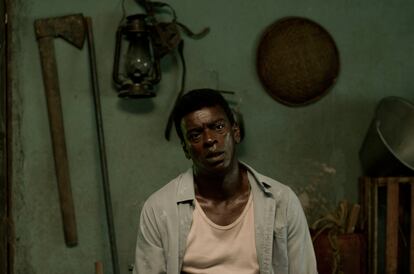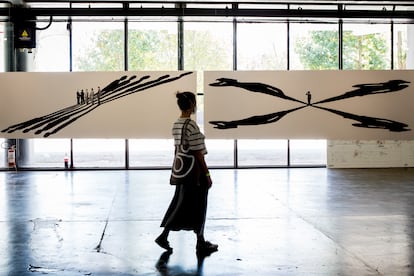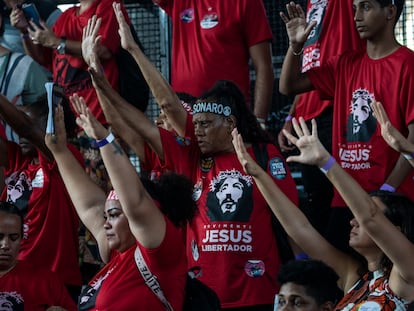Acts of resistance: How Brazilian artists have fought back against Bolsonaro
Brazil’s cultural community is holding its breath before the final round of the elections on Sunday, which will decide if the far-right president will be re-elected, or if leftist Lula da Silva will return to power

Whether he wins or loses Brazil’s runoff election on Sunday, October 30, President Jair Messias Bolsonaro, 67, will be remembered as an antagonist of the arts.
For the past four years, intellectuals, artists, filmmakers and musicians have sought refuge from the right-wing leader’s policies and rhetoric by expressing themselves through creative works. Most have adopted an attitude of resistance against the Bolsonaro administration, which considers Brazilians who work in the cultural sector to be enemies and communists, undeserving of public funds, recognition, or protection.
In one of his first acts as president, Bolsonaro – who began his term in January of 2019 – abolished the ministries of culture, sports and social development. He merged them into a single department called the “Ministry of Citizenship,” dispensing a paltry budget. This perhaps foreshadowed how he would treat cultural life in Brazil for the rest of his tenure.
Most Brazilian artists support 77-year-old Luiz Inácio Lula da Silva – popularly known as “Lula” – in the runoff of the country’s presidential election. They hope that the ex-president – who ruled from 2003 until 2011 – and his left-leaning Workers’ Party will restore arts budgets, heritage protections, educational funding, film festivals and other cultural incentives that were stripepd away by Bolsonaro.
However, it’s not as if Brazil’s artists have simply been sitting on the sidelines for the past four years waiting for a new president to change the situation. They have been hard at work, practicing their crafts. Here are just some of the acts of resistance through art that have taken place in one of the most convulsive periods in recent Brazilian history:
Marighella – bureaucracy as a weapon of censorship
Bolsonaro had been in power for less than two months when the Brazilian film Marighella premiered at the 69th annual Berlin International Film Festival. It marked the directorial debut of Wagner Moura, best-known internationally for playing Palbo Escobar in the Netflix series Narcos.
The film is about the life of Carlos Marighella, a left-wing politician and guerrilla who fought against the Brazilian military dictatorship (1964-85). He died in a shootout with police in 1969.
When Moura walked the red carpet in Berlin, he raised a fist – an act that outraged Bolsonaro supporters, who sank the movie’s score on IMDB before it was even available to the general public.

Other obstacles remained. For two-and-a-half years – much of which coincided with the pandemic – the film’s distribution was stalled by the Brazilian government, which, according to industry sources, used bureaucracy as an instrument of censorship. When it finally got the green light to appear in theaters, going to see it became a political act.
In November of 2021, Marighella was shown in 3,200 Brazilian movie theaters, with 300,000 people going to see it in a single day. It instantly became the most watched Brazilian film of the year.
For many Brazilians, it was surprising to see that the guerrilla – played by the actor Seu Jorge – actually had African ancestry. Marighella – like Machado de Assis, the great master of Brazilian letters – had, for decades, been whitewashed in his immortalization.
Black authors, best sellers
Nothing has left such a deep scar on Brazil as slavery. The legacy of 350 years of trafficking in Black and brown bodies is still with the country today: the descendants of those slaves are poorer and die sooner than their white compatriots.
Writing about slavery in Brazil has typically been confined to thoughtful academic essays and small audiences. However, that changed during the racially-charged Bolsonaro administration. Laurentino Gomes – a journalist of European descent – published the first volume of Escravidao to great acclaim. He placed the issue of slavery in the public debate, thanks to an impactful narrative of sparse language and vivid descriptions, supported by the research of Brazilian and foreign historians. Gomes immerses readers in a reality as horrifying as it is fascinating.
Two years later, Torto Arado – a novel that narrates the lives of sisters Bibiana and Belonísia on a farm in rural Bahia – became the literary sensation of 2021. In addition to leading the sales charts (with more than 100,000 copies sold in less than a year), this poetic tale by Afro-Brazilian writer Itamar Vieira begins with a tragic incident that unites the sisters for the rest of their days. Acclaimed by critics, this novel deals with the heritage of slavery, as well as the struggles of rural life.
Gomes and Vieira are now among the most recognizable faces in Brazilian publishing – a space that has often been closed to stories that deal with Afro-Brazilian narratives. Several books by Black authors are also reaching the best-seller lists in a country where – although Black people and mestizos make up 56% of the population – non-Eurocentric narratives are often erased. This is also a revolutionary considering the general struggles faced by the literary sector in Brazil. With a total population of 214 million, only 50 million books are sold per year… many of these being copies of the Bible.
“It is dark, but I sing”
Eliminating the Ministry of Culture was one of the first promises fulfilled by Bolsonaro when he came to power. The theater director Roberto Alvim was installed as “Secretary of Culture” in the newly-created Ministry of Citizenship. In a government-sanctioned video released in January of 2020 – about a year into his term – he read a message, accompanied by the Brazilian flag, a crucifix and the music of Richard Wagner. Many of the lines were plagiarized from speeches delivered by Nazi Minister of Propaganda Joseph Goebbels:
“The Brazilian art of the next decade will be heroic and national. It will be endowed with a great capacity for emotional involvement… or else, it will be nothing.”
The scandal resulted in his termination. Over the following three years, five more Bolsonaro appointees would pass through the position.

The arts community never forgot the closure of the Ministry of Culture, nor the Goebbels incident. During the 2021 São Paulo Biennial, there was an atmosphere of concern for the direction of the country. That’s why the event was titled Faz escuro, mas eu canto (It is dark, but I sing), after a famous verse by the Amazonian poet Thiago de Mello, written in 1963, near the beginning of Brazil’s military dictatorship.
On the day of the inauguration, the principal curator of the exhibition, Jacopo Crivelli Visconti, said: “It is more important to speak in challenging times than to speak in peaceful times.”
The 34th edition of the biennial will be remembered because one of every 10 invited artists was Indigenous – a gesture of inclusion towards the traditionally forgotten.
More than one history

On September 7, 2022, Brazil celebrated 200 years as an independent nation. In São Paulo’s Ipiranga Museum, the government marked Emperor Pedro I’s decision to break away from Portugal. A tour – one that used the latest technology – was organized, narrating events from the perspective of the mostly white men who oversaw the foundation of the country in the early-19th century.
However, the Museum of Art of São Paulo opted for a radically different examination of Brazil’s founding with the exhibition Histórias Brasileiras (Brazilian Histories).
“At school, we learn that there is only one history… but that’s not the case. History can’t just contemplate one narrative… it must include many,” read a poster that welcomed visitors.
The exhibit included many works of art that referenced unofficial histories that the authorities try to erase, such as crafts from favelas and Amazonian villages, an Africanized Brazilian flag, as well as a sculpture created in 2013 out of bullet casings, in memory of the 5,664 women murdered by their husbands that year.

The power of sertanejo – Brazilian country music
The death of 26-year-old country singer Marília Mendonça in a plane crash shocked Brazil in November of 2021. She was en route to a small town to give a concert.
In the interior of Brazil, agribusiness – the most thriving sector of the economy, thanks to soybeans – has given birth to a class of nouveau riche who are proud of agriculture, Evangelical Christianity and Bolsonaro. These Brazilians wear boots and cowboy hats to attend rodeos and country music concerts.
But the premature death of Mendonça deeply affected the other Brazil – the coastal, samba-loving one – who had discovered the powerful and hoarse voice of the young woman from the southern state of Goiás.

Sertanejo – Brazilian country music – has long been dominated by male duos, macho lyrics and older, conservative audiences. But Mendonça broke with all of this, managing to popularize sertanejo with melodies about passions, suffering, love and heartbreak, from a feminine perspective. She attracted legions of young and female followers, becoming one of the most downloaded singers in Brazil. While the majority of country stars are backing Bolsonaro to the end, Mendonça was against him from the beginning, showing that the musical genre isn’t a monolith.
The Rouanet Law
In 1991, Secretary of Culture Sergio Rouanet – who passed away earlier this year – helped pass a law that created a system in which individuals and companies who invested in cultural projects could receive special tax deductions. This was seen as a good way to help encourage private initiatives in support of the arts, while also helping minor artists write off their expenses.
Bolsonaro has often vilified this law: “[The Rouanet Law] began with good intentions… then it started being used by the Workers’ Party to co-opt the artistic classes.”
The president’s cabinet promoted legal changes that drastically reduced the amount of cultural investment that could be claimed as a tax write-off, while also increasing the length of time it takes to get the artistic merits of an investment approved, from two months to nearly a year. The impact has been devastating.
Adriana Donato – a specialist in the Rouanet Law – tells EL PAÍS by phone from Porto Alegre that “in practice, [the government] just harms minor artists… just the opposite of what they say they intend to do, which is to target wealthy artists. By making the law so difficult to apply, the little artists give up – the ones who need the incentives the most.”
The president has already warned that the law should not be used to finance artistic projects that clash with his ultraconservative values. Hence, any tax incentives for works related, for example, to the LGBTQ community have ended. Meanwhile, funding for gospel music or biblical theater is increasing. An arms company has even received a tax break to publish a book on the history of weapons.
Throughout all of this governmental manipulation, Brazilian artists – even those without many resources – have continued practicing their craft. They hope that a Lula victory will help them survive financially.
Bossa nova pioneers turn 80, campaign for Lula
In 2022, two famous composers from the state of Bahia turned 80. Caetano Veloso and Gilberto Gil helped popularize bossa nova throughout the world, creating the soundtrack to their country.

Neither Veloso nor Gil say a word about retiring. Both men – who were exiled during the military dictatorship – are in excellent shape, with a busy schedule in Brazil and abroad. They – along with 78-year-old Chico Buarque, the youngest pioneer of bossa nova – have been campaigning in favor of Lula.
Those who have turned Brazil into a cultural powerhouse are holding their breath as they await the verdict of the elections. But no matter the result, it is clear that they will all keep following the words of the poet Thiago de Mello, who passed away in January of this year: “It is dark, but I sing.”
Tu suscripción se está usando en otro dispositivo
¿Quieres añadir otro usuario a tu suscripción?
Si continúas leyendo en este dispositivo, no se podrá leer en el otro.
FlechaTu suscripción se está usando en otro dispositivo y solo puedes acceder a EL PAÍS desde un dispositivo a la vez.
Si quieres compartir tu cuenta, cambia tu suscripción a la modalidad Premium, así podrás añadir otro usuario. Cada uno accederá con su propia cuenta de email, lo que os permitirá personalizar vuestra experiencia en EL PAÍS.
¿Tienes una suscripción de empresa? Accede aquí para contratar más cuentas.
En el caso de no saber quién está usando tu cuenta, te recomendamos cambiar tu contraseña aquí.
Si decides continuar compartiendo tu cuenta, este mensaje se mostrará en tu dispositivo y en el de la otra persona que está usando tu cuenta de forma indefinida, afectando a tu experiencia de lectura. Puedes consultar aquí los términos y condiciones de la suscripción digital.
More information
Archived In
Últimas noticias
Most viewed
- Sinaloa Cartel war is taking its toll on Los Chapitos
- Oona Chaplin: ‘I told James Cameron that I was living in a treehouse and starting a permaculture project with a friend’
- Reinhard Genzel, Nobel laureate in physics: ‘One-minute videos will never give you the truth’
- Why the price of coffee has skyrocketed: from Brazilian plantations to specialty coffee houses
- Silver prices are going crazy: This is what’s fueling the rally










































